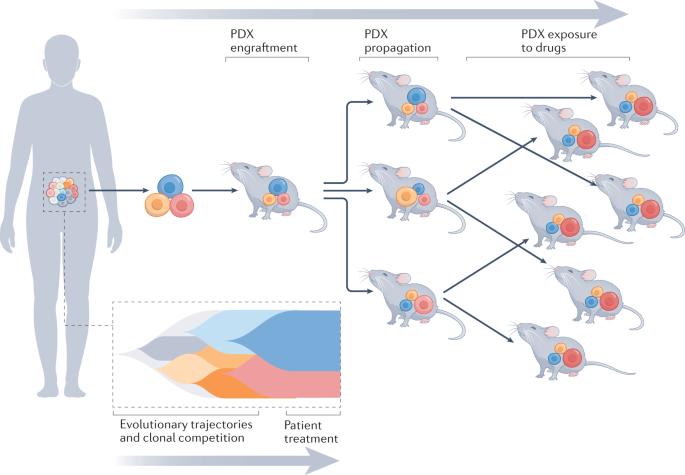Towards precision oncology with patient-derived xenografts
IF 82.2
1区 医学
Q1 ONCOLOGY
引用次数: 20
Abstract
Under the selective pressure of therapy, tumours dynamically evolve multiple adaptive mechanisms that make static interrogation of genomic alterations insufficient to guide treatment decisions. Clinical research does not enable the assessment of how various regulatory circuits in tumours are affected by therapeutic insults over time and space. Likewise, testing different precision oncology approaches informed by composite and ever-changing molecular information is hard to achieve in patients. Therefore, preclinical models that incorporate the biology and genetics of human cancers, facilitate analyses of complex variables and enable adequate population throughput are needed to pinpoint randomly distributed response predictors. Patient-derived xenograft (PDX) models are dynamic entities in which cancer evolution can be monitored through serial propagation in mice. PDX models can also recapitulate interpatient diversity, thus enabling the identification of response biomarkers and therapeutic targets for molecularly defined tumour subgroups. In this Review, we discuss examples from the past decade of the use of PDX models for precision oncology, from translational research to drug discovery. We elaborate on how and to what extent preclinical observations in PDX models have confirmed and/or anticipated findings in patients. Finally, we illustrate emerging methodological efforts that could broaden the application of PDX models by honing their predictive accuracy or improving their versatility. Clinical research needs support from preclinical models that consider the biology and genetics of human cancers during treatment, such as patient-derived xenograft (PDX) models. The authors of this Review discuss how PDX models have been used in the past decade for precision oncology and present emerging approaches that could broaden the application of these models.

利用源自患者的异种移植物实现精准肿瘤学
在治疗的选择性压力下,肿瘤会动态演化出多种适应机制,因此静态地检测基因组变化不足以指导治疗决策。临床研究无法评估肿瘤中的各种调控回路在时间和空间上如何受到治疗刺激的影响。同样,根据不断变化的综合分子信息测试不同的精准肿瘤学方法也很难在患者身上实现。因此,需要结合人类癌症的生物学和遗传学、便于分析复杂变量并能实现足够群体吞吐量的临床前模型,以精确定位随机分布的反应预测因子。患者衍生异种移植(PDX)模型是一种动态实体,可通过在小鼠体内连续繁殖来监测癌症的演变。PDX 模型还能再现患者间的多样性,从而为分子定义的肿瘤亚群确定反应生物标志物和治疗靶点。在本综述中,我们将讨论过去十年中将 PDX 模型用于精准肿瘤学(从转化研究到药物发现)的实例。我们详细阐述了在 PDX 模型中的临床前观察如何以及在多大程度上证实和/或预期了在患者身上的发现。最后,我们说明了新出现的方法学努力,这些努力可以通过提高 PDX 模型的预测准确性或改善其多功能性来扩大其应用范围。临床研究需要临床前模型的支持,这些模型在治疗过程中考虑了人类癌症的生物学和遗传学因素,如患者衍生异种移植(PDX)模型。本综述的作者讨论了过去十年中如何将 PDX 模型用于精准肿瘤学,并介绍了可扩大这些模型应用范围的新兴方法。
本文章由计算机程序翻译,如有差异,请以英文原文为准。
求助全文
约1分钟内获得全文
求助全文
来源期刊
CiteScore
99.40
自引率
0.40%
发文量
114
审稿时长
6-12 weeks
期刊介绍:
Nature Reviews publishes clinical content authored by internationally renowned clinical academics and researchers, catering to readers in the medical sciences at postgraduate levels and beyond. Although targeted at practicing doctors, researchers, and academics within specific specialties, the aim is to ensure accessibility for readers across various medical disciplines. The journal features in-depth Reviews offering authoritative and current information, contextualizing topics within the history and development of a field. Perspectives, News & Views articles, and the Research Highlights section provide topical discussions, opinions, and filtered primary research from diverse medical journals.

 求助内容:
求助内容: 应助结果提醒方式:
应助结果提醒方式:


